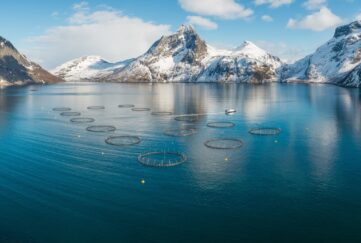SalMar delivers record Q3 results, but SSF continues to struggle

Salmon farming giant SalMar delivered a third quarter operational EBIT or operating profit of almost NOK 2,300m (£169m) although Scottish Sea Farms, in which it owns a half share, continued to produce a loss.
The group EBIT is almost NOK 1,000 (73m) higher than a year, but last year’s figures do not include the NTS group which was not part of SalMar at that time.
The company said it was shelving part of its offshore farming plans due to “regulatory uncertainty” but will fully focus on semi-offshore operations, along with continuing to explore opportunities outside Norway.
Scottish Sea Farms (SSF) reported an improvement in results compared to the previous quarter, but was still affected by persistent biological challenges.
SSF recorded an operating loss of NOK 121m (£8.8m) against a profit of NOK 47m (£3.4m) a year ago on revenues of NOK 867m (£63m) against NOK 972m (£71m) last year.
This represents an operating loss of NOK 13.70 per kilogram (£1). The division harvested 8,800 tonnes, down from 11,300 tonnes in Q3 2022.
SalMar said the weak SSF results are due to biological challenges which have affected average harvest weight, cost base and price achievement.
It added: “In third quarter costs related to biological challenges accounted for £13.1m. Volume guidance for 2023 is reduced with 2,000 tonnes to 25,000 tonnes in order to optimise biological performance.
“Improved biological situation for generations to be harvested in 2024. In 2024 the company expects 37,000 tonnes.”
Strong results for the group
At a group level SalMar reported strong third quarter 2023 results with an operational EBIT for the group of NOK 2,300m (£169m). Total harvest was 78,100 tonnes. Operational EBIT per kg was NOK 29.5.
The operational EBIT for Norway was NOK 2,274m (£165m). Harvest volume was 74,000 tonnes and operational EBIT per kg was NOK 30.70 (£2.23).
The farming segments in Norway delivered strong results driven by continued solid biological and operational performance, which led to increased volume and reduced cost level.
Sales and Industry continued its solid operational performance, demonstrated by its efficient management of harvesting and processing facilities and strong capacity utilisation. The contract share was 15%, with positive contribution.
Icelandic Salmon resumed harvesting in July 2023, after a harvest stop in the second quarter, yet higher costs affected results.
SalMar Aker Ocean has two offshore projects in operation, as Arctic Offshore Farming became part of SalMar Aker Ocean from Q4 2023.
The impact of the resource rent tax (“salmon tax”) in Norway has been included in SalMar’s third-quarter financial statement, calculated for the first nine months of 2023 based on the best current estimate. SalMar said it strongly opposes the tax and remains committed to continue seeking dialogue with authorities and decision-makers.
In the third quarter, SalMar strengthened its financial position with the completion of the sale of Frøy and in the fourth quarter, shareholders voted to cancel NOK 13.1m (£950,000) in treasury shares.
SalMar’s guidance on harvest volumes for 2023 remains unchanged in Norway including SalMar Aker Ocean at 243,000 tonnes. It has increased the guidance for Icelandic Salmon with 1,000 tonnes to 17,000 tonnes and decreased guidance for Scottish Sea Farms with 2,000 tonnes to 25,000 tonnes (100% basis).
Significant volume growth is expected in 2024, SalMar said. The volume guidance is 257,000 tonnes in Norway, 7,000 tonnes from SalMar Aker Ocean, 15,000 tonnes for Icelandic Salmon and 37,000 tonnes for Scottish Sea Farms (100% basis).
SalMar shares rose 6% on the Oslo Stock Exchange today on the back of what are seen as outstanding results.

